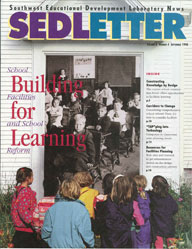Financing Alternatives Call for Flexibility, Creativity
| Scenario 1: | Scenario 2: | Scenario 3: |
| A suburban area, home to a well-respected school district, is flooded with new students. Growth is around 15 percent per year. Residents are generally supportive of the district, but with a tax rate of nearly $2 per $100 valuation, these citizens are not predisposed to voting "yes" to the next bond package. | This inner-city school has a mobile population. Some parents work two to three jobs to support their families. The property in the area generates little wealth, but has a high ratio of children in schools. The building badly needs repair and teachers must make do with out-of-date equipment. The principal must depend on grants from the state to upgrade his facilities, but his school is one of many vying for a limited amount of money. | This rural area has seen better economic times. Although inner city schools get media attention because of their facility woes, schools in this district are among the 30 percent of rural schools across the country in need of extensive repair and renovation. Property taxes are already high here, but the property is of low value, especially when compared to the property in a near-by resort area. |
The situations are different, but these scenarios are replayed across the SEDL region. And, these facilities problems boil down to one issue - money. And though financial markets have greatly changed in the past twenty years, most school buildings are financed the same way they have been for decades - districts usually depend upon general obligation bonds to raise money for construction and renovation projects.
Since the 1970s, most states have created some type of financial assistance program earmarked for school facilities. This assistance ranges from a high of $2,254 per student in Alaska to a low of $6 per student in Montana. Most states have prioritized funding, favoring the districts with less ability to pay, and most provide aid in the form of grants rather than loans. Some states like Arizona and Michigan have taken radical steps to revamp school financing, but other states are reluctant to do so because most citizens favor local control over school issues.
Some financing options to consider, other than increasing direct state aid, are taken from "The Question that Won't Go Away," by Lynne Zempel in the Spring 1997 issue of Probe:
Adopt lease or lease-purchase plans.
Some of these plans include purchase of certificates of participation (COPs), a type of lease-back financing instrument similar to an installment purchase agreement. The district makes lease payments for a specified time. After making all of its lease payments, the district owns the property. The lessor considers the lease payment to be the equivalent of principal and interest to a government agency and therefore does not pay federal income tax on the portion of the lease payments attributable to interest. One advantage of COPs is that they are not strictly debt obligations, and so are exempt from direct voter approval and debt limitations. They also offer more liquidity than other types of financing.
Establish business/community partnerships.
There are many ways local businesses can participate in school renovation or construction efforts. In one district, a builders' association donated materials and labor to build an addition to the local high school. In another district, area corporations provided money for equipment, bonuses, and other expenses to free-up district funds for school infrastructure projects. One suggestion for urban areas has been to recreate mixed-use neighborhoods where office building owners might be offered some type of tax relief in return for dedicating space for school use.
Impose impact fees.
Fast-growing districts may be able to assess developers a fee in much the same way cities and counties do to obtain revenue for utilities and police and fire protection. A school impact fee could shift much of the cost burden from a broad taxpayer base to those who move to an area so their children may attend the schools. Curbing residential development is another option taken by some rapidly growing areas such as Park City, Utah.
Expand existing programs.
Resources not currently aimed toward school financing could be revamped to include school construction and renovation. An example is the Agriculture Department's Rural Development Administration (RDA) which provides low-cost, long-term loans for constructing community facilities. By law, borrowers from RDA must demonstrate they cannot obtain credit elsewhere.
Make bond issues more attractive to voters.
The October 1996 issue of School Planning and Management Magazine offers strategies for winning a bond election. Its advice includes:- Focus on the positive vote by calling every parent in the district, providing information regarding the issues and asking for their support;
- Limit the campaign period in order to curtail the time that opposition forces have to organize;
- Emphasize projected overcrowding;
- Compare yourself to other districts (e.g., what features do you lack compared to nearby districts?);
- Register positive voters;
- Ask for endorsements from business and religious leaders;
- Involve community members in the planning process to ensure there will be some community buy-in from the beginning; and
- De-emphasize cost by putting the million-dollar figure in human terms. An example of this last strategy is to depict the daily cost to the average homeowner, such as it will cost each homeowner "less than a cup of coffee or can of soda a day."
Next Article: Corridors to Change: Comprehensive school reform models may change the way you look at your facilities

